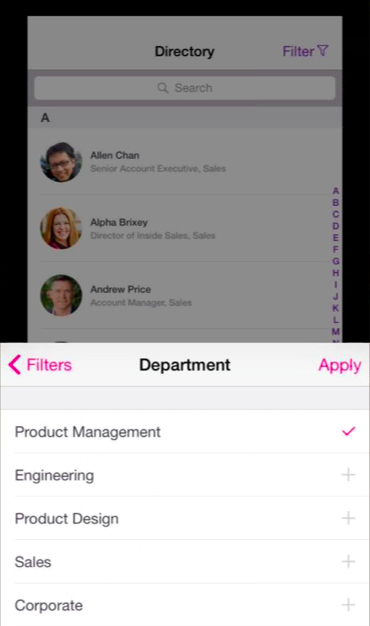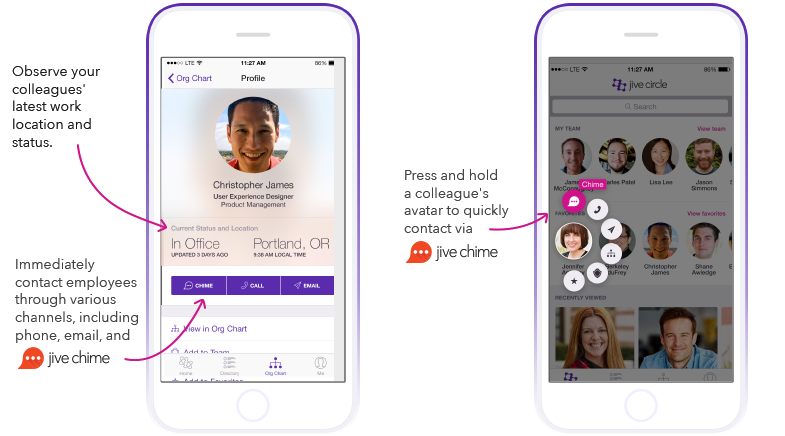Today Jive Software announced Jive Circle (Circle), the latest edition to their portfolio of single purpose mobile applications, named Jive-w, for “work-style” applications. Circle is a corporate directory application that allows iOS and Android users to quickly lookup information about their colleagues. Circle joins Jive Chime (Chime), a mobile messaging application that was launched earlier this year, and Jive Daily, a future application focused on sharing content and conversations. Early Access to Jive Circle begins August 31.
Pricing information is currently not available.
Getting To Know You
Circle has an attractive mobile interface, filled with the common “circle avatars” found in most of today’s applications. Clicking on a person’s picture brings up their profile page, filled with standard contact information that can be pulled from active directory. From there you can see where a person fits into the corporate organizational chart, initiate a conversation with them via Jive Chime (if you have it installed) or email, or phone them. Long pressing on an avatar pulls up shortcut icons for each of those actions saving you a few clicks. These features make it simple to discover and connect with colleagues, something that is often a challenge in companies today.
One of the most useful features of Circle is the ability to filter the directory based on several different faccets, allowing you to easily find the people you are looking for.

While Circle’s contact features are useful, I’d like to see it provide more detailed contextual relationship information such as a history of messages, phone calls or meetings, groups you have in common, content you’ve shared, etc. Circle is also limited to internal colleagues, it does not import/sync with connections in other tools the way a product like Nimble does. I’d also like to see integration within device’s native applications like email, phone and contacts, but that is limited by what the OS allows, not something Jive can control.
Expanding Jive’s Reach
Jive has been one of the leaders in social business for many years, providing community software to over 1000 customers. However, that success has created an image for the company that they (and their shareholders) don’t want to be restricted to. To help remove the typecast of “web based community software”, the Jive-w line of applications are designed to help Jive reach new customers thus providing additional revenue streams. Jive Chime, Circle and (the upcoming) Daily are designed for the mobile centric world, and don’t require users to be existing customers of Jive-n or Jive-x.
Don’t Forget Your Base
While the Jive-w applications are designed to reach new customers, Jive needs to be careful not to alienate their existing (paying) customers. The features of Jive Chime and Circle are ones that existing customers may also want, so I’m unsure of why Jive created them as separate applications versus deconstructing the existing product into smaller (mobile) components. For example, conversations in Chime do not carry over to Jive-n or Jive-x communities and profile information from Circle such as favourites and groups are not carried over to the full Jive directory. Compare that to Facebook, where they removed messaging functionality from the core Facebook mobile application and created a separate FB Messenger. This allows people to quickly and easily send chat messages without having to look at the entire Facebook stream… but if you access the full Facebook experience on the web, the FB Messenger conversations are there, it’s not a separate expereince.
Not Standing Still
Jive is doing the right thing embracing mobile and expanding their portfolio. Jive Chime provides the short, causal messaging style that is gaining popularity as a communiation channel at work. Circle provides a nice set of features that will allow people to easily engage with their colleagues while on the go from their mobile devices. Long term, I believe Jive needs to reconcile the current divide between the Jive-w applications and their Jive-n/x community software or they will face several challenges with data integration, licensing, business partner eco-system and more.

